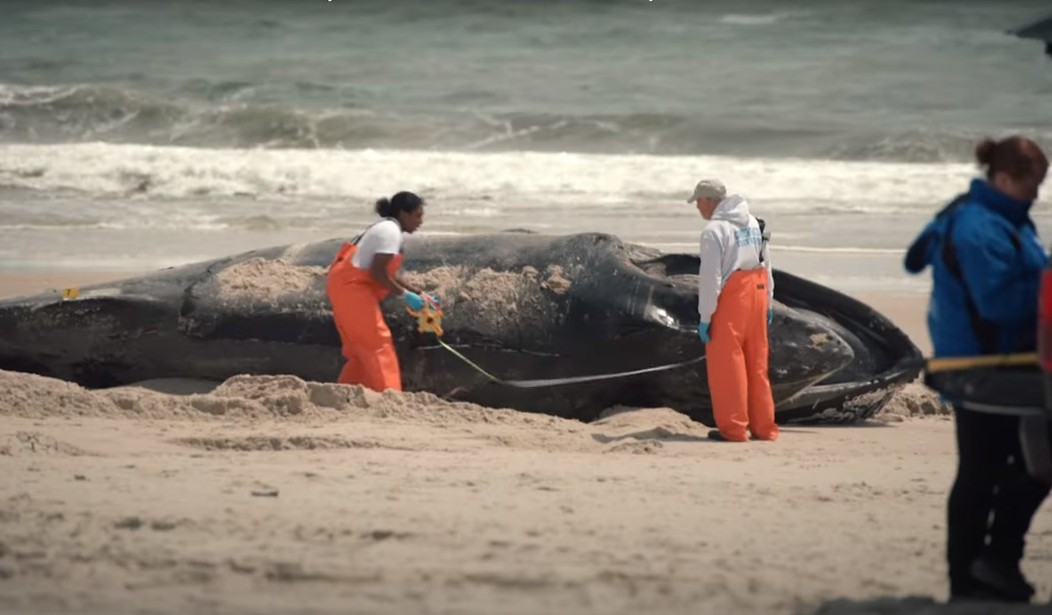"Save the Whales" was the rallying cry of Greenpeace and other environmental extremists in the 1970s and 1980s, and it might be time for them to pull it out of the attic, dust it off, and use it again. Since 2016, 204 humpback whales have died off the east coast of the United States, most of them in the area of New Jersey to Massachusetts and North Carolina to Virginia. This number is far from norms in numbers, and the clustering is unusual. Many of the whales have been killed by boat strikes, but that still doesn't explain why the number of humpback whale deaths jumped by over 100% from 2015 to 2016.
There are several moving parts here. First, this is not the product of the imagination. The number of humpback whale deaths has skyrocketed since 2016.

Credit: NOAA/2016–2023 Humpback Whale Unusual Mortality Event Along the Atlantic Coast
The problem has attracted the attention of the National Oceanic and Atmospheric Administration's National Marine Fisheries Service (aka NOAA Fisheries), which has investigated and produced a study called 2016–2023 Humpback Whale Unusual Mortality Event Along the Atlantic Coast.
Correlation is not causality, but the number, timing, and distribution of the deaths have caused attention.
This map shows where the humpback whale deaths happened.

Credit: NOAA/2016–2023 Humpback Whale Unusual Mortality Event Along the Atlantic Coast
The tabular data provides granularity to the map depiction.

Credit: NOAA/2016–2023 Humpback Whale Unusual Mortality Event Along the Atlantic Coast
What these two pieces of data have in common is that 1) the first offshore wind farm went into operation in 2016, and 2) there are two wind farms in operation, one off of Cape Henry, VA, and another off Block Island, RI.
If you were a detective, you might call this a clue.
As soon as the kill-off of whales was discovered, offshore wind farms were blamed. That would never do as "renewables" are the Holy Grail of the environmental movement, and blaming hideous and inefficient wind farms for whale deaths would be a huge black eye, perhaps on the order of the genocide of birds attributed to regular wind farms.
What's interesting to watch is the framing of government and wind industry denials. This is NOAA:
NOAA determined the project by Danish wind power company Orsted “is likely to adversely affect, but is not likely to jeopardize, the continued existence of any species” of endangered whales, sea turtles, and other animals. Nor is it likely to “destroy or adversely modify any designated critical habitat.”
...
“No serious injury or mortality of any (endangered) whale is anticipated as a result of the proposed project,” the report read. “We do not expect any right whales to be exposed to increased sound levels that would result in injury; all effects to right whales will be limited to temporary behavioral disturbance. Additionally, no effects to the features of right whale critical habitat are anticipated.”
They've determined that the wind farms will "adversely affect" whales but not so much as to kill them. Also note that the denial focuses on a species of whale, the right whale, that is not dying in droves. Even more duplicitous is the answer served up by Factcheck.org. These are the people who get folks like us demonetized when we don't follow the party line.
Scientists suspect a variety of factors are behind the whale deaths, which appear to be a continuation of a years-long period of unusually high mortality for marine animals. Contrary to claims made by critics of wind energy, there is no indication that the strandings have anything to do with seafloor surveys being done in preparation for the installation of wind turbines.
The acoustic sources being used in these surveys are either completely out of the hearing range of baleen whales or only capable of slightly disturbing their behavior, an expert told us. Regulations also require operators to make sure there are no whales nearby when conducting a survey.
“There’s basically zero chance that those surveys have caused any mortality,” Douglas Nowacek, the chair of marine conservation technology at Duke University, told us in a phone interview.
Again, this is a case study in denying what no one is saying. No one cares about the "hearing range of baleen whales," because the issue is humpback whales. While we're at it, which is it?
completely out of the hearing range of baleen whales or only capable of slightly disturbing their behavior
You can't have both of those conditions unless the hearing range of the whales is immaterial.
Yes, there is concern about the surveys, but the issue is the effect of two operational wind farms at ground zero of two clusters of dead humpback whales. The real issue concerns the sounds produced by the operation of the wind turbines and associated equipment and the increased ship traffic in previously remote areas.
You'd think the same environmental movement that put national security at risk by forcing the end of sonar testing by US submarines would be up in arms. But you'd be wrong.
The bottom line is that a huge, multi-billion dollar gift is at stake, and government, industry, and their fluffers in the media all know that if offshore wind farms are associated with the kill off of whales and other marine mammals, that industry is dead. This is the same behavior that led to the environmentalists shutting down nuclear power in Germany and replacing it with coal-burning generators.
Into this debate is thrown a new documentary called "Thrown to the Wind," which shows how political pressure paid for by industry campaign contributions is pushing an industry that has been inadequately studied, if not outright harmful to marine mammals.
The documentary highlights dissenting opinions within NOAA about the dangers of wind farms.
Our research shouldn’t have been necessary. Dr. Sean Hayes, a top NOAA scientist warned last year that industrial wind projects “could have population-level effects on an already endangered and stressed species.”
“Population-level effects” include extinction.
...
Dr. Hayes, NOAA’s chief of protected species warned that “oceanographic impacts from installed and operating turbines cannot be mitigated for the 30-year lifespan of the project unless they are decommissioned.” His warnings were ignored.
So, too, were the ones from scientists representing many of the same environmental groups supporting the industrial wind energy projects wrote in a 2021 letter that “the North Atlantic right whale population cannot withstand any additional stressors; any potential interruption of foraging behavior may lead to population-level effects and is of critical concern.”
But the scientists then stood by as their organizations sold out them and the whales.
As was to be expected, the documentary that was viewed by over 6 million people in 48 hours was blocked by Facebook.
And Facebook went so far as to censor my post linking whale deaths to wind energy off the East Coast of the United States.
The censorship came in the form of adding a link to a “FactCheck.org” article from March 31, 2023, which relied entirely on U.S. government sources “Thrown to the Wind” debunks.
The issue is finally getting some attention, and a handful of Republicans want hearings before construction begins on 20+ Atlantic Coast wind farms in the next few years.












